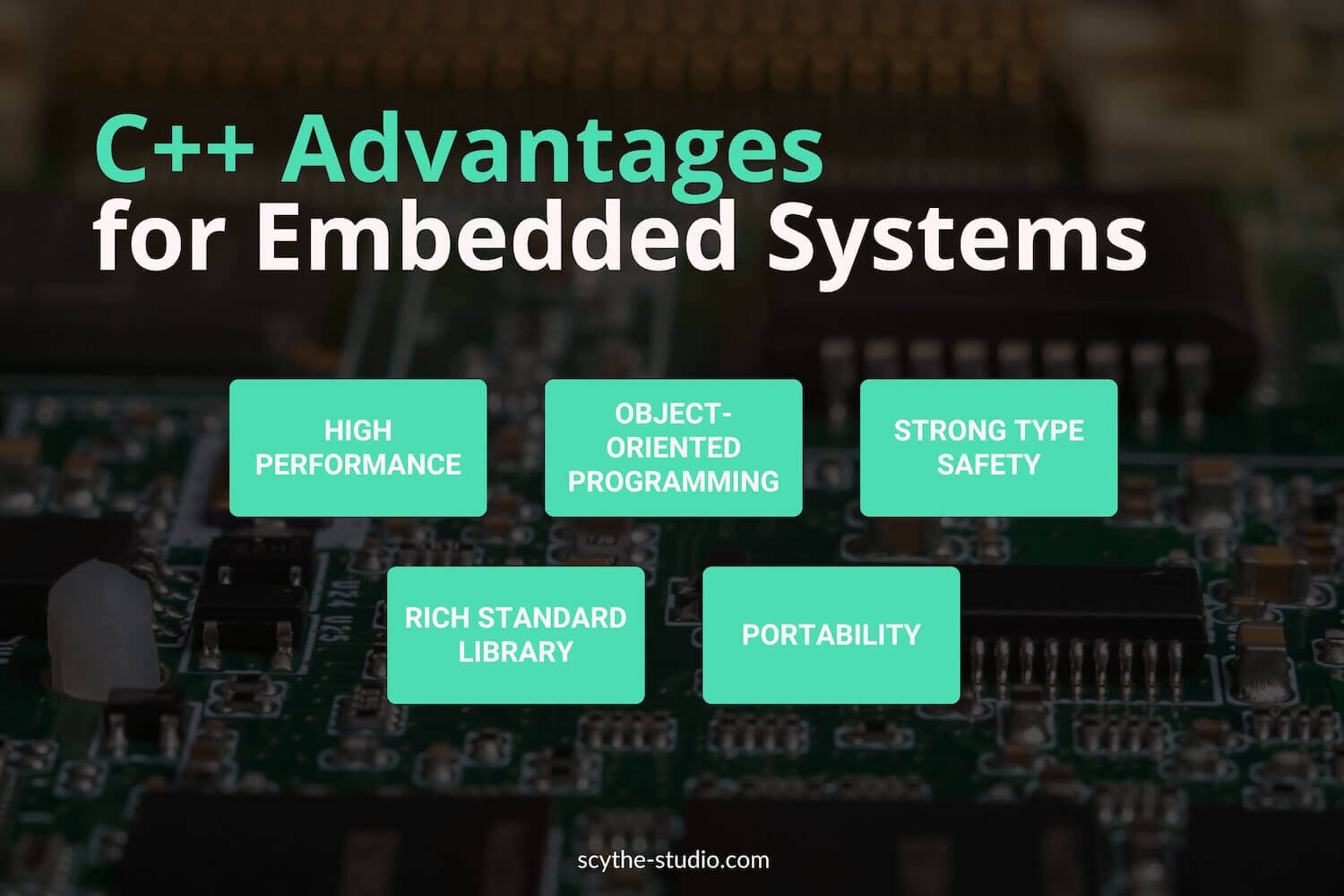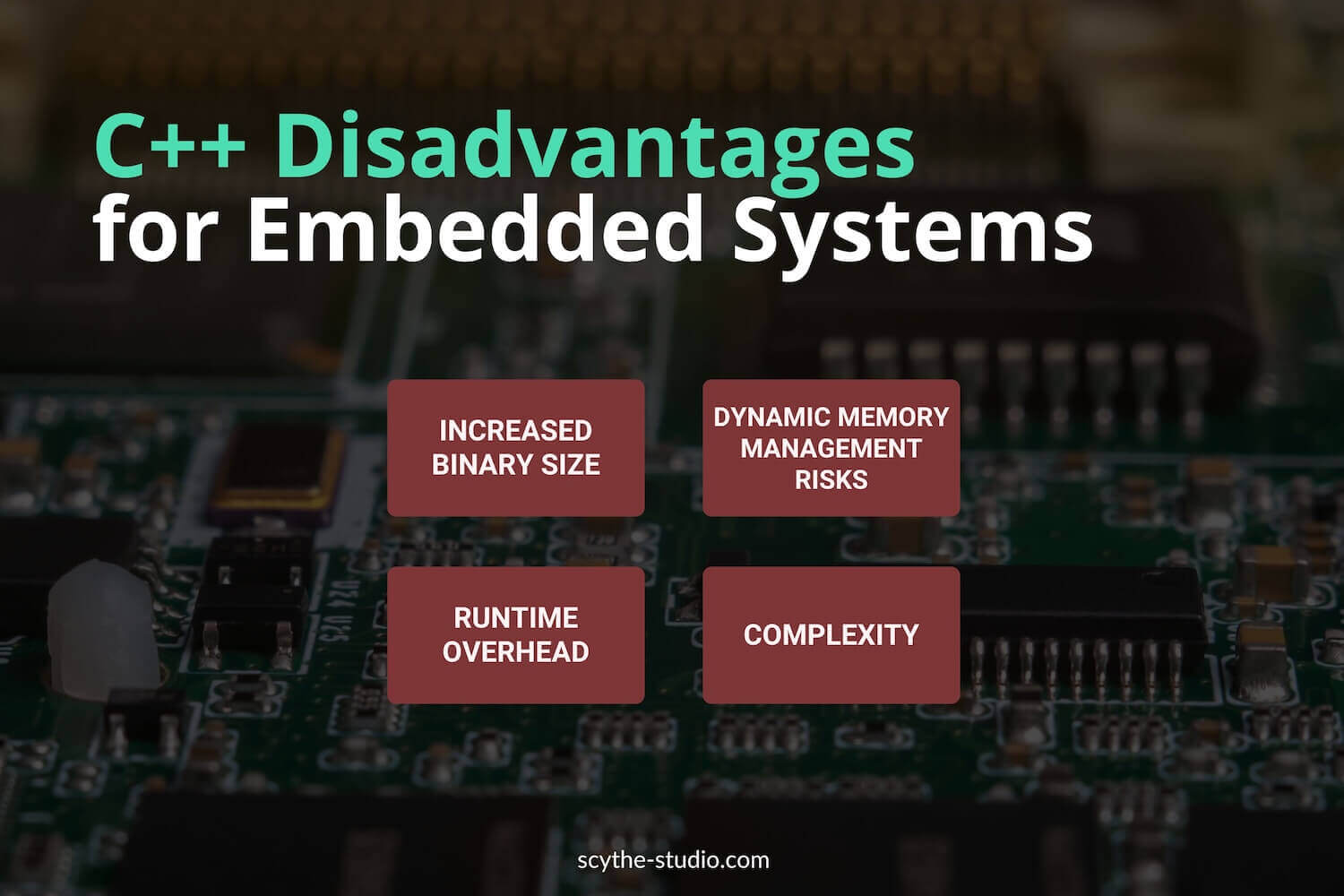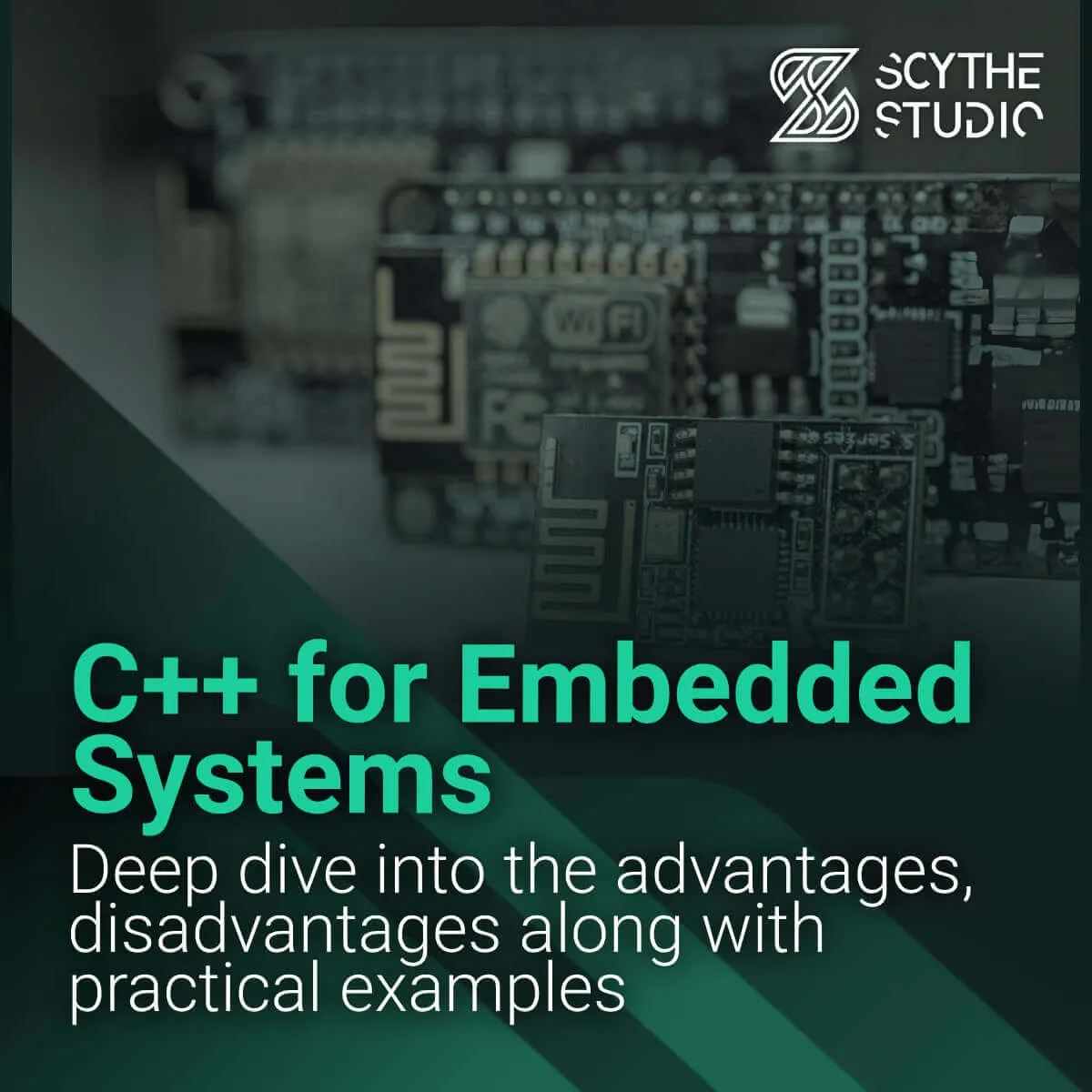Why Consider C++ for Embedded Systems?
Embedded systems range from simple microcontrollers to complex real-time applications that demand efficient resource management and reliability. As embedded projects get more complex, developers seek programming languages that give performance and scalability and safety and maintainability.
Among the many languages used in embedded development, C++ is the best option. It has the low level hardware control of C and modern features like object oriented programming (OOP), templates and strong type safety. So it’s the perfect choice for high performance, scalable and maintainable embedded applications.
C++ advantages for embedded systems
- High Performance: C++ compiles to efficient machine code, uses system resources optimally in embedded environments. Unlike interpreted languages, C++ gives low level access to hardware and high level abstractions for clean design. Many high performance systems use C++ because of its ability to use memory efficiently and minimize CPU cycles.
- Object-Oriented Programming: OOP in C++ enhances modularity, code reuse and scalability which is essential in large embedded projects. Base classes, virtual functions and member functions allow developers to create hierarchical code structures, making it easier to manage complex systems. C++ also supports polymorphism which can help create flexible user interfaces and adaptable firmware architectures.
- Strong Type Safety: C++ does strong type checking at compile time, reduces the chance of memory corruption and hard to debug issues. C code allows more implicit conversions which can introduce subtle bugs in embedded systems programming. By using strongly typed enums, smart pointers and type inference, embedded developers can prevent common programming mistakes.
- Rich Standard Library: C++ Standard Library has many ready to use tools including data structures, math functions and memory management utilities. By using these libraries, embedded developers can avoid writing duplicate code, improve productivity and reduce development time. Heavy use of templates in STL improves code efficiency while reducing the need for redundant code.
- Portability: C++ can be compiled for many architectures, so it’s a good choice for embedded systems where hardware can change. Many real-time operating systems (RTOS) and bare metal firmware projects support C++, so you can easily migrate between platforms. Writing portable code reduces the need to rework when porting to new embedded devices.
 C++ advantages for embedded systems
C++ advantages for embedded systems
C++ disadvantages for embedded systems
- Increased Binary Size: Some C++ features like STL, RTTI and exceptions can increase binary size. In resource constrained embedded devices, bloat can be a problem. But by disabling unnecessary features, using compiler optimizations and selecting lightweight libraries, embedded developers can minimize the impact on code size.
- Dynamic Memory Management Risks: Heap allocation in embedded code can cause memory fragmentation which is a big problem in real-time systems. Unlike C code where developers manually manage memory, C++ has smart pointers and RAII (Resource Acquisition Is Initialization) to manage memory safely. But in embedded projects, the best practice is to use stack allocation and static objects whenever possible. C++ allows developers to enforce this approach by implementing custom allocators.
- Runtime Overhead: Some language features like exception handling, virtual functions and RTTI introduce runtime overhead. This can impact performance critical applications in embedded systems programming. Disabling exceptions and using manual error handling can mitigate these issues so your embedded code remains efficient.
- Complexity: C++ has a big learning curve, especially for developers coming from other languages like C. Understanding templates, inheritance and memory management requires extra effort. But for large embedded projects, the benefits of modularity, reusability and scalability outweigh the initial learning investment.
 C++ disadvantages for embedded systems
C++ disadvantages for embedded systems
C++ in embedded development: Pros and Cons table
| Aspect |
Pros |
Cons |
| Performance |
C++ compiles to efficient machine code, optimizes CPU and memory usage. |
Some C++ features introduce slight runtime overhead compared to pure C. |
| Modularity and Reusability |
Object-Oriented Programming allows for modular, reusable and scalable code. |
OOP adds abstraction which can add complexity for smaller projects. |
| Type Safety and Debugging |
Strong type checking reduces runtime bugs and simplifies debugging. |
Transitioning from C can be difficult due to stricter type requirements. |
| Standard Library Support |
Standard library has many ready-to-use tools, reduces development time. |
Using STL carelessly can increase machine code size. |
| Cross-Platform Portability |
Code can be compiled for different embedded devices and architectures. |
Some real-time operating systems require special adaptation for C++. |
| Binary Size |
Compiler optimizations and feature selection can reduce code size. |
STL, RTTI and exceptions increase binary size. |
| Memory Management |
Smart pointers and RAII help manage memory safely. |
Heap allocation causes fragmentation which impacts real-time performance. |
| Runtime Overhead |
Zero-overhead abstractions simplify code without compromising execution efficiency. |
Virtual functions, RTTI and exception handling introduce runtime overhead. |
| Learning Curve and Complexity |
Encourages structured design, good for large embedded projects. |
Steeper learning curve than C, requires more embedded expertise. |
Comparison of embedded programming languages: C++ vs. C vs. Python vs. Rust
| Aspect |
C++ |
C |
Python |
Rust |
| Performance |
High performance, close to C when optimized. |
Very high performance with minimal abstraction overhead. |
Low performance due to interpretation and runtime overhead. |
Comparable to C/C++ with zero-cost abstractions. |
| Memory Management |
Manual and automatic (RAII) memory management. |
Manual memory management, requires careful handling. |
Automatic garbage collection, which can introduce latency. |
Ownership model enforces safe and efficient memory management. |
| Code Safety |
Strong type safety, but use RAII to avoid traps. |
Weak type safety, memory corruption errors are common. |
High-level safety with strong typing and built-in guards. |
Strongest safety guarantees, no memory leaks or data races. |
| Ease of Use |
More complex than C, but has powerful abstractions. |
Simple syntax, embedded developers understand it. |
Very easy to use, readable syntax, beginner-friendly. |
More complex than Python, but safer than C and C++. |
| Standard Library |
STL and many advanced features. |
Minimal standard library, you must implement yourself. |
Extensive standard library with many modules. |
Growing standard library with built-in safety and concurrency features. |
| Concurrency |
Limited built-in support, threads and atomics are available. |
No built-in concurrency, uses OS-specific libraries. |
Limited built-in concurrency, but multiprocessing is available. |
Built-in concurrency with safe threading. |
| Binary Size |
Larger than C due to language features. |
Smallest binary size, good for low-resource devices. |
Big due to interpreter and runtime dependencies. |
Smaller than C++ but larger than C due to safety checks. |
| Portability |
Highly portable, used in many embedded systems. |
Portable across many architectures. |
Not portable for bare-metal systems, often requires an OS. |
Portable with good cross-compilation support. |
| Use Cases in Embedded Systems |
Real-time systems, device drivers, RTOS applications. |
Firmware, low-level hardware interaction. |
Scripting, data processing, high-level control layers. |
Used in safety-critical systems, real-time applications and secure embedded development. |
Practical applications of C++ in embedded systems
Device Drivers
C++ is used to write device drivers, to have low-level control while having code abstraction. Many modern embedded devices, microcontrollers and peripherals use C++ based drivers because of their efficiency and flexibility.
RTOS Integration
Many real-time operating systems (RTOS) integrate well with C++, so embedded developers can handle concurrency, multithreading and task scheduling efficiently. Some features like RAII and smart pointers make resource management in RTOS based embedded projects easier.
Communication Protocols
C++ is good for custom communication protocols and using existing libraries for networking. Many embedded systems require efficient and reliable data transfer, C++ provides that through optimized message handling and error detection algorithms.
Signal Processing
Embedded systems for audio processing, sensor data analysis and image recognition often use C++ for performance critical code. C++ support for advanced math operations makes it suitable for high performance systems that need real-time data processing.
Arduino Framework
The most popular open-source development platform that provides a simplified way to write and upload code to microcontrollers is based on C++.
3D Printers
Marlin an open-source firmware for 3D printers, CNC machines, and other motion control devices is written in C++.
Drones and UAVs
ArduPilot the most advanced, full-featured, and reliable open source autopilot software supporting many vehicle types: multi-copters, traditional helicopters, fixed wing aircraft, boats, submarines, rovers and more is developed in C++.
 Practical Applications of C++ in Embedded Systems
Practical Applications of C++ in Embedded Systems
C++ sample code for an embedded system
The following example demonstrates C++ usage on the beginner-friendly Arduino platform:
#include
class LedController {
public:
LedController(uint8_t pin) : _pin(pin), _brightness(0) {
pinMode(_pin, OUTPUT);
}
void setBrightness(uint8_t brightness) {
_brightness = brightness;
analogWrite(_pin, _brightness);
}
void blink(uint16_t intervalMs) {
digitalWrite(_pin, HIGH);
delay(intervalMs);
digitalWrite(_pin, LOW);
delay(intervalMs);
}
private:
uint8_t _pin;
uint8_t _brightness;
};
LedController led(9); // Pin 9 (PWM-capable)
void setup() {
Serial.begin(115200);
led.setBrightness(128); // Set LED to 50% brightness
}
void loop() {
led.blink(500); // Blink every 500ms
}
C++ is supported by ESP-IDF – Espressif IoT Development Framework for Espressif SoCs. The support includes the following features:
- Exception Handling
- Multithreading
- Runtime Type Information (RTTI)
- Thread Local Storage (thread_local keyword)
- Filesystem Library
Below is an example with ESP-IDF-C++:
#include
#include
#include
#include "esp_log.h"
#include "gpio_cxx.hpp"
using namespace idf;
extern "C" void app_main(void)
{
try {
const GPIO_Output gpio(GPIONum(4));
while (true) {
gpio.set_high();
std::this_thread::sleep_for(std::chrono::seconds(1));
gpio.set_low();
std::this_thread::sleep_for(std::chrono::seconds(1));
}
} catch (GPIOException &e) {
std::cerr << "GPIO exception occurred: " << esp_err_to_name(e.error)) << std::endl;
}
}
What to keep in mind when using C++ for embedded development?
Don’t use Dynamic Memory Allocation
Heap allocation can cause memory fragmentation in embedded systems with limited resources. Embedded developers should use stack allocation, static objects and pre-allocated memory pools to manage memory.
Don’t use Exceptions
Disabling exception handling increases runtime overhead and binary size. Many embedded compilers provide options to disable exceptions and use manual error handling to keep high performance systems.
Size Optimization
To keep code size minimal, developers should manage libraries, use compiler/linker optimizations and avoid features. This will ensure embedded projects fit in the hardware constraints of embedded devices.
Testing and Debugging
Use embedded specific debugging tools, unit tests and profilers to ensure reliable embedded systems programming. Embedded developers should use static analysis tools and hardware debug probes to detect and fix issues early.
Follow these guidelines and C++ can be used in embedded systems, for performance and scalability of modern embedded projects.
Is C++ the right language for your project?
C++ is good if your embedded system needs high performance, modularity and advanced features like object oriented programming. But if simplicity or ultra low level hardware control is a priority, C or even assembly might be better. Knowing the trade-offs is key to making the right decision.
Need Help Choosing the Right Technology? Contact Us!
Not sure if C++ is the right choice for your embedded project? Our team of embedded systems experts is here to help! Contact us today!
Przemysław Sowa Chief Technology Officer


 C++ advantages for embedded systems
C++ advantages for embedded systems C++ disadvantages for embedded systems
C++ disadvantages for embedded systems Practical Applications of C++ in Embedded Systems
Practical Applications of C++ in Embedded Systems


